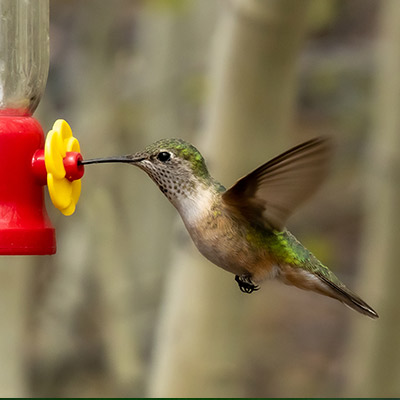by Kristin Love
5 Backyard Tips to Help Pollinators Survive and Thrive
The name of the game is pollination! But why should we care? Without pollinators, humanity and all of Earth’s terrestrial ecosystems would not survive. Of the 1,400 crop plants grown around the world, almost 80% require pollination by animals. So how can you help?
Pollinators are responsible for one out of three bites of food we take each day. They are essential for the health of our ecosystems and the health of many of our food crops. However, pollinator populations are declining worldwide largely due to habitat loss and pesticide poisoning. Even minor changes in our own backyards can help pollinators survive and thrive. Like all of us, these hard-working creatures need food, water, and shelter.
Provide a Habitat: Planting native flowers that bloom at various times. Nectar-rich flowers attract both insect pollinators and hummingbirds. Find a list of suggestions based on season: Pollinator Plant Suggestions for Georgia – Center for Urban Agriculture (ugaurbanag.com)
Hydration: Place a shallow dish of water on your deck or windowsill to help thirsty pollinators stay hydrated. By placing several semi-submerged stones in the water dish, you can provide pollinators with places to land so they can drink without running the risk of drowning. Also, consider hanging hummingbird feeders with ONLY sugar water, for extra nutrition!

Leave the Leaves Be: Dead leaves and plant material are food and shelter for pollinators in the winter. Resist the urge to rake your leaves in the fall and let them support pollinators throughout the winter season.
Control the use of Pesticides: Pollinators can be harmed if they consume nectar or pollen that has come into contact with pesticides. You can help reduce the risk of exposure by utilizing other insect-control methods or by applying pesticides at night when bees and other pollinators are inactive.
Create a Home: Diverse types of pollinators require different things. Some bees and pollinating beetles may use downed tree limbs and logs; many butterflies lay eggs and rear their young on plants; a small patch of bare ground might serve ground-nesting bees. Potential nesting sites include trees (both living and dead), shrubs, brush piles, bare ground, and bee boxes.

Have more questions about how to get started on your gardening adventure?
Check out the U.S. Fish & Wildlife Service’s tips and tricks to grow! How to build a pollinator garden | U.S. Fish & Wildlife Service (fws.gov)
You can also join us here at Elachee Nature Science Center for Discovery Saturdays in June to visit our onsite pollination station with honeybees and for pollinator crafts and activities suited for the entire family! Find your next event by visiting https://www.elachee.org/events.
